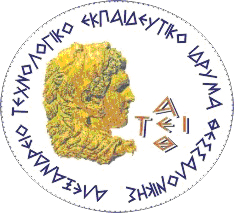
ALEXANDER TECHNOLOGICAL EDUCATIONAL INSTITUTE OF THESSALONIKI
| |
| Home |
| The Department |
| Studies |
| Contact |
| Thessaloniki |
THESSALONIKI |
Thessaloniki, the second largest city in Greece with a population of more thes 1.000.000 inhabitants, is one of the oldest cities in Europe. It was founded in 316 B.C. on a site of old prehistoric settlements dating back to 2300 B.C., by Cassander, king of Macedonia, and was named after his wife, sister of Alexander the Great. Since then, Thessaloniki has become the chief city of Macedonia. In Roman times it boasted the largest harbour in the whole region and stood on the spot where the great road from the north met the main east-west artery. Many foreign merchants lived temporarily or permanently in this rich commercial centre. It was visited also by Saint Paul, who preached the new religion, and who later addressed his two well-known epistles to the Christians of Thessaloniki. Galerius, the ruler of one of the two parts of the Eastern Roman Empire, chose Thessaloniki as his imperial seat in A.D. 300 Byzantine times At about the beginning of the Byzantine period in Thessaloniki, the Metropolitan Acholios or Ascholios converted the Emperor Theodosius I to Christianity and baptized him, and on Feb. 28, 380 Theodosius issued the famous decree proclaiming the Nicene Creed the only true creed, and condemning all others as heresies. However, this act was marred 10 years later (390) by the slaughter of thousands of Thessalonikians in the city's Hippodrome, where the present Hippodromiou Square is. The slaughter was ordered by Theodosius to punish the people of Thessaloniki for an uprising during which some Goths of his personal guard had been killed and the city authorities temporarily overturned. About 100 years of peace and progress followed, but at the end of the 5th century new invasions of Goths, Avars, Huns and Slavs took place. The area around Thessaloniki, as with other parts of Greece, was subjected to pillage, slaughter, devastation and captivity, but the attackers never managed to take the city itself. A great deal of information about this period is given in the later books on the Miracles of Saint Demetrius. The judicial power, an indispensable part of the community's independence, was in the hands of the archbishop. Information re garding this comes from the time of the Venetian occupation (1423- 1430) and although of a later date it contributes to a more complete understanding of the main points of Greek law during Venetian and Turkish rule.
|
Web administrator: D. Boutakidis
The new website of the AGRICULTURAL DEVELOPMENT and AGRIBUSINESS MANAGEMENT was co-funded by the European Social Fund and National Resources
